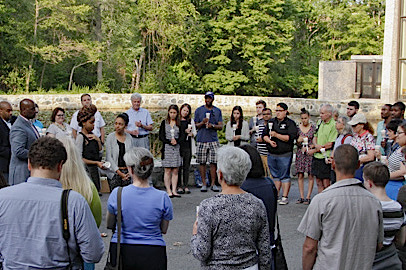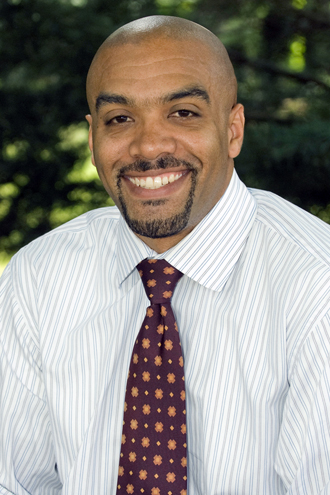Charleston, one year later: Prof. Chad Williams looks back on the tragedy
Williams started the hashtag #CharlestonSyllabus and has since co-edited a book offering historical context for the shootings
 Photo/Mike Lovett
Photo/Mike LovettThe Brandeis community held a vigil for the shooting victims in June 2015.
Following the shootings at the Emanuel A.M.E. church in Charleston, South Carolina on June 17, 2015, Associate Professor of African and Afro American studies Chad Williams started up the hashtag #CharlestonSyllabus on Twitter as a way to contribute historically informed perspective to the conversation.
The outpouring of responses quickly became an online resource hosted by the African American Intellectual History Society. At that point it was more of a curated reading list than a true syllabus that could serve centerpiece for a curriculum on the shootings.
Along with Kidada E. Williams of Wayne State University, and Keisha N. Blain of the University of Iowa, Williams transformed the syllabus project into a resource for the classroom by turning it into a book: “Charleston Syllabus: Readings on Race, Racism, and Racial Violence.”
One year after the shootings in Charleston, Williams took some time to answer some questions for BrandeisNow.
Immediately after the shootings, you noticed a formation of narratives in the media that you found to be misinformed. Now, one year later, how have these narratives changed?
 |
| Chad Williams |
The #CharlestonSyllabus was born out of frustration with how both the media and politicians had been discussing the Emanuel A.M.E. church shooting. Dylann Roof was portrayed as a lone, troubled young man whose views on race and black people were an aberration, and not reflective of something deeper and more widespread. Debates surrounding the Confederate flag failed to seriously engage with the history of slavery, the Civil War and the Confederacy itself.
The overarching narrative of the massacre soon became about the need for unity and forgiveness, as opposed to a true reckoning with what took place and why. I imagine, one year later, this will remain the case.
However, I do think that scholars and activists have made important progress in educating students and the broader public about the need to not just view the Charleston shooting as a singular event, but instead part of a much longer history of racial violence directed towards African Americans that has larger implications for how we understand the history of the nation.
How do you think awareness of, opposition to, and support for white supremacy today compares to past eras of US history?
The Charleston shooting demonstrated how white supremacy remains deeply imbedded in every facet of American society. This should not be surprising when we consider the very founding of the country itself and how whiteness determined who was and was not worthy of the right to life, liberty and the pursuit of happiness.
Of course, over the duration of United States history, significant changes in race relations have taken place, mostly for the better. Progress has been real. The removal of the Confederate flag from the grounds of the South Carolina state capitol, after years of protest, is a perfect example of how the America of 1960 or 1860 no longer exists. While acknowledging how vestiges of the past remain with us in the present, as a historian it is important that I also recognize change over time.
However, that does not mean that white supremacy is a thing of the past. We need only to look at the ascendency of Donald Trump to see how racism, and white supremacy specifically, remains alive and well. The fact that Trump, whose entire campaign is rooted in racist appeals to white voters who feel that the country, as they imagined it, no longer exists, can become the nominee of Republican Party indicates that the lessons of Charleston have not been fully learned. The refusal of the overwhelming majority of Republican elected officials to unequivocally repudiate Trump speaks to a lack of moral conviction when it comes to challenging racism. Such cowardice disgraces the memories of those killed in the Charleston shooting.
While there are differences in their historical contexts, do you see some parallels between the narratives that formed immediately after Charleston and what we are seeing now with the shootings in Orlando?
The Orlando Pulse nightclub shooting comes tragically almost one year after the Charleston Emanuel AME Church massacre. Both shootings demonstrate the dangerous relationship between intolerance – whether for the LGBTQ community or African Americans – and this country's culture of gun violence. They also reveal important differences in how we talk about terrorism. Whereas the media and politicians questioned whether or not the Charleston shooting constituted an act of terror, the Orlando shooting was immediately labeled as such.
African Americans certainly saw the Charleston tragedy as part of a longer history of white terrorist violence. The difference between Charleston and Orlando seems to be based largely on perceived differences between the two gunmen, specifically in regards to their race, faith and political motivations. The language we use to describe these two incidents matters, as they shape how we view their severity and what response is warranted from the state.
What are some of the advantages of having the syllabus as a physical resource, and how did the syllabus change in the process of turning it into a book? How is the book different from the online collection?
One of the first questions I asked myself after the creation of the Twitter and online #CharlestonSyllabus resource was what did it mean to call this a syllabus. Through the hashtag, we had developed a truly remarkable crowdsourced reading and reference list. This, however, was not the same as a syllabus.
In approaching the creation of the book, I, along with my co-editors, worked to develop clear themes based on the online collection that provided readers with structure and a roadmap to understanding the historical significance of the Charleston shooting. While many of the readings we included in the book were drawn from the original #CharlestonSyllabus, we also selected some new readings to fully flesh out the themes we wanted to explore. Our main goal was to make the Charleston Syllabus as accessible as possible and provide an opportunity for educators to make use of it in the classroom.
From your perspective as a historian, what does the response to #CharlestonSyllabus say about the role social media plays in informing, educating and influencing the public?
I was amazed by the response to the #CharlestonSyllabus on Twitter immediately following the shooting. The fact that now, one year later, it has had such longevity is equally remarkable. Social media has transformed the dissemination of African American history and how it is taught.
If used conscientiously, social media can be an extremely effective tool in educating a broader public beyond the all too often exclusive walls of academia. Twitter has proven to be especially useful in linking contemporary racial issues and discussions with historical resources. In the past year I have noticed a plethora of different hashtag syllabi, such as #MizzouSyllabus, #BlkWomenSyllabus, #CubaSyllabus, #BlackPantherSyllabus, #LemonadeSyllabus, and most recently #RootsSyllabus. I would like to think that this is in part due to the success of the #CharlestonSyllabus and its demonstrated impact.
Categories: Humanities and Social Sciences, Research





